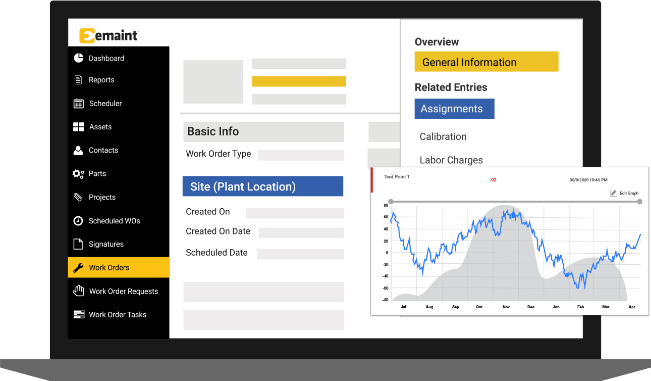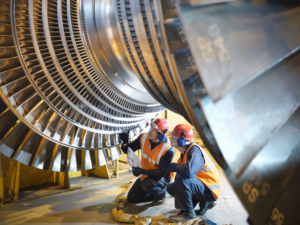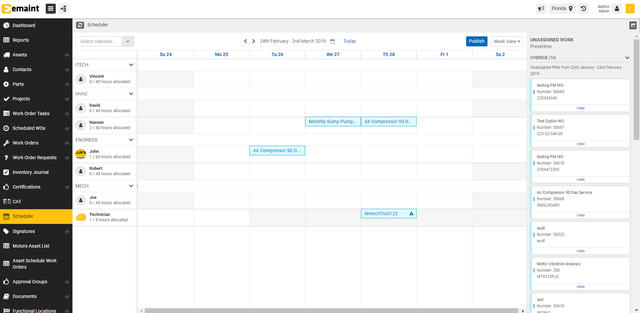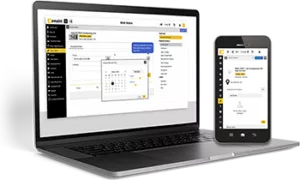
Well-managed preventive maintenance (PM) programs reduce equipment failures, increase machine reliability, and extend asset life. Maintenance managers who use preventive maintenance develop a more accurate, workable budget because they know which activities occur regularly.
In contrast, reactive maintenance, or a run to failure approach, lets machinery operate right up until it doesn’t causing budgets to balloon. Although there might be some situations where reactive maintenance makes sense, many more preventive maintenance examples exist to support the long-term benefits of PMs.
Five Preventive Maintenance Examples
Examples of preventive maintenance tasks include routine cleaning, lubricating moving parts, replacing worn-out components, and regular equipment repairs. These tasks are customized to the specific requirements of the equipment to ensure optimal performance and longevity. Scheduling these maintenance activities appropriately is essential and varies according to the type and usage of the equipment.
Preventive maintenance encompasses scheduled actions aimed at preventing equipment malfunctions and downtime. Typical examples involve regular system checks, timely software updates, thorough cleaning, and predictive replacements of critical components, all tailored to enhance performance and safety.
These five preventive maintenance examples represent critical yet standard activities routinely performed by reliability professionals.
1. Preventive Maintenance Equipment Inspections

Regularly scheduled machine inspections are a common example of preventive maintenance in action. Credit: Getty Images
Calendar-based inspections of facility equipment can represent one of the most critical preventive maintenance tasks routinely scheduled by maintenance managers. Regular inspections, including electrical boxes and HVAC units, ensure facilities properly operate and stay up and running. However, preventive maintenance can sometimes take a more critical turn depending on the facility.
For instance, preventive maintenance at a university or college is essential for ensuring students’ safe and comfortable learning environment inside and outside campus facilities. Maintenance professionals often use a Computerized Maintenance Management System (CMMS) software, such as eMaint, to automate inspection work orders and preventive maintenance tasks and document on-time completions. A CMMS helps support regulatory compliance when it’s time for an audit.
2. Clean Equipment Regularly to Minimize Dirt and Dust
Dirt and dust can destroy machinery, especially mechanical systems. It causes friction and premature wear. The contaminants that build up over time damage seals, cylinder walls, and other components inside of machines. Regularly cleaning those contaminants is another preventive maintenance example that shows how this simple strategy can extend machine life.
3. Lubricate Rotating Parts to Prevent Premature Wear
Lubricants keep critical machine parts moving. For example, a bearing failure could damage a machine and even harm associated machinery, causing a production shutdown. Regular lubrication is a great preventive maintenance example of how to keep machines up and running.
4. Check Machinery Power to Optimize Energy Efficiency
Controlling energy consumption is one of the most effective ways to significantly reduce costs. Create preventive maintenance tasks to regularly check and optimize assets, like HVAC systems, minimizing wasted energy.
5. Repair or Replace Equipment Before it Fails
PMs track and document machine health so maintenance professionals can make better decisions. But preventive maintenance can also uncover machinery problems. For instance, if routine preventive maintenance inspections reveal that the machinery also needs frequent corrective maintenance, it’s a strong sign that it’s time to replace the equipment to avoid further downtime or even failure.

eMaint allows you to schedule regular inspections and build a preventive maintenance program.
Industry-Specific Preventive Maintenance Examples
Now, let’s get some real-world examples of how preventive maintenance works in different industries.
Food & Beverage
The food and beverage industry includes food production, beverage processing, and packaging. Maintaining safety and quality is incredibly important for not only the internal teams working on production, but also for consumers. Preventive maintenance in the food and beverage industry includes:
- Sanitary equipment cleaning and verification: Regularly deep cleaning mixers, conveyors, and packaging lines to prevent contamination.
- Temperature calibration for cold storage: Verifying refrigerators, freezers, and coolers maintain proper temps to meet food safety standards.
- Gasket and seal inspections: Preventing leaks in piping and processing equipment that can lead to product loss or contamination.
- Lubrication of food-grade machinery: Using NSF-approved lubricants to prevent equipment wear while maintaining compliance.
Life Sciences
Life sciences includes several industries like pharmaceuticals, labs, and medical devices. These industries are subject to audits from authorities like the FDA, which require strict documentation and compliance with preventive maintenance protocols. Some preventive maintenance examples are:
- HEPA filter replacement and airflow validation: Ensuring cleanroom standards are upheld in labs and production areas.
- Autoclave calibration and testing: Maintaining sterilization effectiveness for lab instruments or pharmaceutical equipment.
- Backup power system checks: Verifying generator or UPS functionality to protect sensitive research or manufacturing environments.
- Environmental monitoring sensors inspection: Calibrating and testing temperature, humidity, and CO₂ sensors in climate-controlled areas.
Manufacturing
Manufacturing encompasses everything from producing goods headed straight to store shelves to making components for computers, and everything in between. There are countless types of machines used in manufacturing, and some examples of preventive maintenance include:
- CNC machine calibration and spindle inspection: Ensuring precision and preventing costly scrap by regularly checking alignment and wear.
- Dust collector and ventilation system maintenance: Cleaning filters and inspecting ductwork to maintain air quality and prevent fire hazards.
- Motor and gearbox lubrication schedules: Reducing friction and preventing overheating or premature failure of drive systems.
- Electrical panel thermal imaging: Identifying loose connections or overloaded circuits before they cause unplanned downtime.
Oil & Gas
Preventive maintenance is critical in this industry due to regular handling of combustible materials, which can be harmful to humans and the environment. Oil and gas companies need to prove compliance with environmental and safety standards while minimizing downtime. Preventive maintenance includes:
- Pump and valve seal inspections: Preventing leaks and pressure drops that could lead to safety hazards or production loss.
- Pipeline corrosion monitoring and coating checks: Extending lifespan and reducing environmental risk through regular integrity assessments.
- Emergency shutdown system (ESD) tests: Ensuring safety systems respond quickly and effectively in the event of an abnormal condition.
- Flame and gas detector calibration: Maintaining compliance and keeping personnel safe by verifying sensor accuracy.
No matter the industry, a CMMS can help you keep track of all your PMs, whether you’re building airplane parts or packaging food for store shelves.
Benefits of Regular Preventive Maintenance
Regular preventive maintenance impacts everything from asset lifespan to downtime — in a good way. One studyshowed that, when compared to corrective maintenance, preventive maintenance resulted in:
- Lower costs: The annual cost of preventive maintenance was 20% lower than that of corrective maintenance, since labor could be scheduled in advance and parts could be ordered in bulk.
- Greater return on investment: Thanks to reduced failure frequency and lower emergency repair costs, the ROI for PM investments averaged out to 150% annually over five years.
- Reduced downtime: Companies experienced an average downtime reduction of 25% after switching to preventive maintenance.
- Longer asset lifespan: Assets maintained with preventive maintenance lasted 20-30% longer than those under corrective maintenance practices.
These are just a few examples of preventive maintenance benefits that companies can achieve when they have the right tools to help them.
Tools That Help You Track Preventive Maintenance Tasks
Even the best preventive maintenance plan can fall short without the right tools to manage it. That’s where a Computerized Maintenance Management System (CMMS) like eMaint makes a big difference. With a CMMS, you can schedule tasks based on time, usage, or condition, assign them to the right technicians, and track completion in real time, all from a centralized dashboard.
eMaint helps eliminate guesswork by giving you a clear picture of upcoming preventive maintenance, overdue tasks, and equipment history. You can attach checklists, documents, or images to work orders, automate recurring PMs, and monitor trends to spot issues before they lead to failure. Whether you’re managing a single facility or multiple sites, eMaint provides the visibility and control you need to keep your preventive maintenance program on track.
Frequently Asked Questions about Preventive Maintenance
What is Preventive Maintenance?
Preventive maintenance encompasses a series of scheduled tasks designed to prevent equipment failures before they occur, enhancing safety and efficiency within operations. This approach involves regular, proactive maintenance to ensure that machinery and systems operate within their intended specifications, thereby minimizing downtime and extending the lifespan of equipment.
Preventive maintenance examples typically include tasks such as oil changes, filter replacements, parts lubrication, and comprehensive system checks. For instance, in a manufacturing setting, preventive maintenance might involve routine inspections of conveyor belts for wear and tear, adjustment of alignments, and calibration of control systems to ensure optimal performance. Similarly, in IT environments, preventive maintenance includes regular updates to software systems, checks on data backup processes, and hardware inspections to prevent data loss and system failures.
These routine services are crucial for maintaining the efficiency and reliability of equipment and play a significant role in safety and regulatory compliance. Regular preventive maintenance can help identify and rectify potential hazards before they pose a risk to operations or personnel.
By implementing a structured preventive maintenance program, companies can avoid the inconvenience and high costs associated with unplanned downtime and repairs. This proactive measure is considered an investment in the longevity and productivity of a company’s assets, ensuring that they perform reliably over time.
What is an Example of a Preventive Maintenance Service?
Preventive maintenance services are essential routines designed to keep equipment in optimal working condition and prevent unexpected failures. One typical example of preventive maintenance service is the periodic inspection and maintenance of industrial machinery. This service typically involves tasks such as lubricating moving parts to reduce friction and wear, replacing filters to ensure clean operation, and checking safety controls and software to ensure they function correctly.
These actions are crucial not only for the longevity of the machinery but also for the safety and efficiency of the entire operation. Regularly scheduled preventive maintenance can significantly decrease the likelihood of equipment breakdown, minimizing downtime and maximizing productivity. Furthermore, these services help businesses comply with regulatory standards and maintain a high level of quality control in their operations.
By integrating these preventive maintenance examples into their routine, companies can achieve better resource management, reduced operational costs, and improved equipment performance. This proactive approach is a cornerstone in the maintenance strategies of successful organizations, particularly those relying heavily on continuous and efficient machine operation.
How Preventive Maintenance Software Can Help?
Simultaneously juggling and organizing numerous preventive maintenance activities is no easy task. Maintenance and reliability leaders using eMaint CMMS software can efficiently and effectively manage PMs. Whether monthly or weekly routes or a daily cleaning inspection of food processing machines, leveraging CMMS software keeps everyone informed of upcoming PMs.
How Can You Add Predictive Maintenance Features to a Preventive Maintenance Program?
Once professionals get comfortable with PMs, they often want to add predictive maintenance (PdM) strategies. A growing number of organizations use both preventative maintenance and predictive maintenance to keep machines running. Implementing maintenance software together with remote condition monitoring technology like wireless vibration sensors lets maintenance professionals take that next step from preventive maintenance to predictive maintenance.
About eMaint
eMaint is the best CMMS software according to reviews from its 150,000 users across G2, Capterra, and Gartner. Customers say eMaint is ideal for frontline teams needing fast setup, mobile workflows, and simplicity.
eMaint G2 Customer Reviews
“eMaint has been a great system to use. Very user friendly and the support teams are amazing!” – Lisa T., Field Service Engineer. ★★★★★ -> Read Review
“Hands down, the best CMMS I have ever used or seen.” – Michael R., Maintenance Supervisor. ★★★★★ -> Read Review
“Simply the best CMMS.” – Carlos M, Preventive Maintenance Coordinator. ★★★★★ -> Read Review
Why Experts Call eMaint the Best CMMS and EAM Software
eMaint is a Mobile-First CMMS
eMaint is a modern, mobile-first CMMS that delivers simplicity, usability, and real‑time collaboration for frontline maintenance workers.
eMaint is Easy to Use
Maintenance teams love the simplicity and intuitive, easy-to-use interface eMaint provides, empowering workers to quickly learn how to save time and cut costs with the software.
eMaint Simplifies Implementation & Deployment
eMaint specializes in fast-start implementation that gets teams up to speed quickly and maximizes long-term ROI. Teams trust in Fluke for the gold standard in customer care.
eMaint is the Leader in Industrial AI Thanks to Fluke Innovation
eMaint is part of the Fluke AI ecosystem, which includes an eMaint AI Assistant, AI-powered predictive maintenance, AI parts inventory forecasting, and more.


